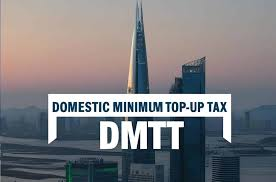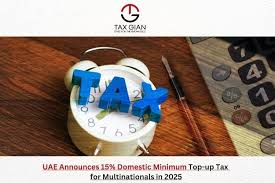Now Reading: Domestic Minimum Top-Up Tax (DMTT) in the UAE: What Multinational Enterprises Need to Know in 2025
-
01
Domestic Minimum Top-Up Tax (DMTT) in the UAE: What Multinational Enterprises Need to Know in 2025
Domestic Minimum Top-Up Tax (DMTT) in the UAE: What Multinational Enterprises Need to Know in 2025

Table of Contents
the UAE introduced the Domestic Minimum Top-Up Tax (DMTT) via Cabinet Decision No. 142 of 2024, effective for financial years starting on or after January 1, 2025. The UAE has solidified its position as a global business hub, with its real estate market achieving 226,000 transactions valued at AED 761 billion (USD 207 billion) in 2024, a 36% year-on-year increase, according to the Dubai Land Department (DLD). As part of its commitment to international tax standards,
This tax, aligned with the OECD/G20’s Pillar Two framework, ensures large multinational enterprises (MNEs) pay a minimum 15% effective tax rate (ETR) on profits. Targeting MNEs with consolidated global revenues of €750 million (approximately AED 3 billion or USD 793 million) in at least two of the four preceding fiscal years, the DMTT impacts sectors like real estate, technology, and hospitality. This guide provides U.S.-based MNEs, particularly those investing in UAE real estate, with a comprehensive overview of the DMTT, its compliance requirements, and strategic considerations for 2025.
Overview of the UAE DMTT

Purpose and Alignment with OECD Pillar Two
The DMTT is a component of the OECD’s Global Anti-Base Erosion (GloBE) Model Rules under Pillar Two, designed to curb profit-shifting to low-tax jurisdictions and ensure a global minimum tax rate of 15%. Introduced through Federal Decree-Law No. 60 of 2023 and detailed in Cabinet Decision No. 142 of 2024, the UAE DMTT applies a top-up tax on low-taxed UAE entities to achieve a 15% ETR, supplementing the UAE’s 9% corporate tax (CT) regime. This aligns with the UAE’s removal from the FATF Grey List in 2024 and its goal to enhance fiscal transparency while remaining a competitive investment hub.
Scope and Applicability

The DMTT applies to MNE groups operating in the UAE with:
- Consolidated global revenues of €750 million or more in at least two of the four fiscal years immediately preceding the tested fiscal year.
- Constituent Entities (CEs), including subsidiaries, joint ventures (JVs), permanent establishments (PEs), and minority-owned entities, regardless of ownership interest. JVs are treated as separate MNE groups for DMTT calculations, with the JV entity acting as the ultimate parent entity (UPE).
Exclusions:
- Small and medium enterprises (SMEs) and purely domestic businesses with no cross-border operations.
- Investment entities, which are exempt from the top-up tax.
- Entities in Free Zones with 0% CT rates (e.g., DMCC, JAFZA) are not exempt from DMTT if they meet the revenue threshold.
Effective Date
The DMTT is effective for financial years starting on or after January 1, 2025. For MNEs with a calendar-year fiscal period, compliance begins January 1, 2025, with the first DMTT return due by March 31, 2026 (15 months after fiscal year-end, extended to 18 months for the first year).
Key Provisions of the DMTT

Calculation of the Top-Up Tax
The DMTT ensures a 15% ETR by applying a top-up tax on the difference between the current ETR and 15%. The process involves:
- Pillar Two Income or Loss: Calculated based on Financial Accounting Net Income or Loss from standalone financial statements, typically under International Financial Reporting Standards (IFRS). If IFRS is impractical, another acceptable standard may be used with adjustments for permanent differences. Adjustments include specific items like non-deductible expenses or tax-exempt income.
- Effective Tax Rate (ETR): Derived by dividing adjusted covered taxes by the net qualifying income of UAE CEs. If the ETR is below 15%, a top-up tax is applied to bridge the gap.
- Simplified ETR Relief: For fiscal years starting in 2025, if an MNE’s simplified ETR is 16% or higher (17% in 2027), the DMTT may not apply.
- Transitional Safe Harbours: For fiscal years beginning on or before December 31, 2026 (excluding those ending after June 30, 2028), safe harbours reduce compliance burdens:
- De Minimis Test: No DMTT if total revenue of UAE CEs is less than €10 million and profit/loss before tax is under €1 million.
- Simplified ETR Test: No DMTT if the ETR is 16% (2025) or 17% (2026).
- Routine Profits Test: No DMTT if profits are below the substance-based income exclusion amount.
Filing and Administration
- DMTT Return: MNEs must submit a DMTT return within 15 months of the fiscal year-end (18 months for the first year). A designated filing entity can submit on behalf of the group, or CEs can file individually.
- Registration: UAE CEs must register with the Federal Tax Authority (FTA) for DMTT, with details pending.
- Payment: Top-up tax is due alongside the DMTT return.
- Pillar Two Information Return: MNEs must file a GloBE Information Return and notification, as specified by future Ministerial Decisions.
- Country-by-Country Reporting (CbCR): The FTA uses CbCR data to assess compliance, requiring robust data systems.
Penalties and Compliance
The DMTT includes a general anti-avoidance rule (GAAR) and penalties for non-compliance, though specific details will be clarified by the FTA. MNEs must maintain accurate records and enhance reporting systems to meet GloBE requirements.
Implications for MNEs in Real Estate
Impact on Real Estate Investments
U.S.-based MNEs with UAE real estate operations, such as developers or property management firms, are likely subject to the DMTT if they meet the €750 million revenue threshold. Key considerations:
- Increased Tax Liability: The DMTT raises the ETR from 9% (UAE CT rate) to 15% for low-taxed entities, impacting profit margins. For example, a real estate MNE with AED 100 million in UAE profits and a 9% ETR would face a 6% top-up tax (AED 6 million).
- Free Zone Entities: Real estate firms in Free Zones (e.g., DMCC) with 0% CT are not exempt from DMTT, potentially increasing costs for projects like off-plan developments in Dubai South.
- Rental Income: While residential rentals are VAT-exempt, commercial property income may trigger DMTT if the MNE’s ETR falls below 15%, requiring careful tax planning.
Strategic Opportunities
- R&D Tax Incentives: From January 1, 2026, MNEs can benefit from 30-50% refundable tax credits for R&D activities, encouraging innovation in sustainable real estate (e.g., LEED-certified projects like Dubai Sustainable City).
- High-Value Employment Incentives: Effective January 1, 2025, refundable tax credits for employing C-suite executives or senior staff can offset DMTT costs for real estate MNEs with significant UAE operations.
- Safe Harbours: Real estate MNEs with low UAE profits may qualify for transitional safe harbours, reducing compliance burdens in 2025-2026.
Compliance Strategies for U.S.-Based MNEs
- Assess Scope: Confirm if the MNE meets the €750 million revenue threshold using consolidated financial statements. Review UAE CEs, including JVs and PEs, to determine DMTT applicability.
- Calculate ETR: Model the ETR for UAE operations to estimate top-up tax liabilities. Use IFRS-based financials and adjust for GloBE-specific items.
- Leverage Safe Harbours: Evaluate eligibility for de minimis, simplified ETR, or routine profits tests to minimize compliance efforts in the first two years.
- Enhance Data Systems: Upgrade financial reporting systems to extract data for CbCR and GloBE calculations, ensuring compliance with FTA requirements.
- Engage Experts: Partner with UAE tax consultants (e.g., PwC, N R Doshi & Partners) to navigate DMTT complexities and optimize tax strategies.
- Monitor U.S. Tax Obligations: U.S.-based MNEs must report UAE income on Form 1040, filing FBARs for accounts exceeding USD 10,000. Consult U.S.-UAE tax specialists to avoid double taxation, as no tax treaty exists.
Challenges and Mitigation
- Compliance Complexity: The DMTT’s data-intensive requirements (e.g., CbCR, GloBE adjustments) increase administrative burdens. MNEs should invest in tax technology and training.
- Free Zone Impact: Free Zone entities face unexpected tax costs, requiring budget adjustments. Explore R&D and employment incentives to offset liabilities.
- Global Coordination: MNEs must align UAE DMTT compliance with Pillar Two rules in other jurisdictions (e.g., EU, Singapore). Centralized tax teams can streamline reporting.
- Pending Guidance: The FTA’s forthcoming regulations may clarify penalties and filing details. MNEs should monitor updates via official MoF and FTA channels, avoiding unverified sources like social media.
Why U.S.-Based MNEs Should Act Now
The UAE’s DMTT, effective January 1, 2025, reinforces its alignment with global tax standards while maintaining a competitive edge with no personal income tax, no annual property tax, and high real estate yields (6-8%). ranks the UAE among the top five markets for cross-border investment, driven by policies like the Golden Visa (10-year residency for AED 2 million property investments). Despite the DMTT, the UAE’s tax structure remains attractive compared to the U.S., where corporate taxes reach 21% and capital gains taxes hit 20%. U.S.-based MNEs in real estate can capitalize on opportunities in Dubai’s thriving market—projected 5-10% price growth in 2025—while ensuring DMTT compliance.
Conclusion
The UAE’s DMTT, effective January 1, 2025, introduces a 15% minimum tax for MNEs with €750 million in global revenues, aligning with OECD Pillar Two. For U.S.-based MNEs in real estate, the DMTT increases tax liabilities for low-taxed entities, including Free Zone operations, but offers opportunities through R&D and employment incentives. By assessing scope, calculating ETR, and leveraging safe harbours, MNEs can navigate compliance while capitalizing on the UAE’s tax-free real estate market. Partnering with tax experts and monitoring FTA guidance will ensure U.S. investors thrive in the UAE’s dynamic economy in 2025.
WATCH MORE: https://www.youtube.com/watch?v=Y8jqSF-_SM8
READ MORE: UAE Corporate Tax Reform 2025: Key Changes and Implications for Businesses






















